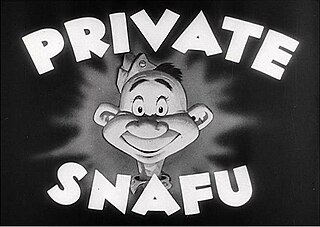
SNAFU is an acronym that is widely used to stand for the sarcastic expression Situation normal: all fucked up. It is a well-known example of military acronym slang. It is sometimes bowdlerized to "all fouled up" or similar. It means that the situation is bad, but that this is a normal state of affairs. The acronym is believed to have originated in the United States Marine Corps during World War II.

Private Snafu is the title character of a series of black-and-white American instructional adult animated shorts, ironic and humorous in tone, that were produced between 1943 and 1945 during World War II. The films were designed to instruct service personnel about security, proper sanitation habits, booby traps and other military subjects, and to improve troop morale. Primarily, they demonstrate the negative consequences of doing things wrong. The main character's name is a play on the military slang acronym SNAFU, "Situation Normal: All Fucked Up". The cleaned-up version of that phrase, usually used on radio and in print, was "Situation Normal: All Fouled Up".

Plasmodium falciparum is a unicellular protozoan parasite of humans, and the deadliest species of Plasmodium that causes malaria in humans. The parasite is transmitted through the bite of a female Anopheles mosquito and causes the disease's most dangerous form, falciparum malaria. It is responsible for around 50% of all malaria cases. P. falciparum is therefore regarded as the deadliest parasite in humans. It is also associated with the development of blood cancer and is classified as a Group 2A (probable) carcinogen.
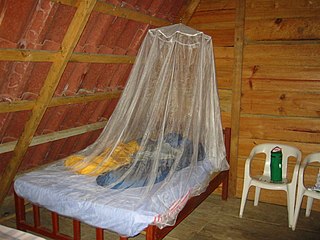
A mosquito net is a type of meshed curtain that is circumferentially draped over a bed or a sleeping area, to offer the sleeper barrier protection against bites and stings from mosquitos, flies, and other pest insects, and thus against the diseases they may carry. Examples of such preventable insect-borne diseases include malaria, dengue fever, yellow fever, zika virus, Chagas disease and various forms of encephalitis, including the West Nile virus.

Yankee Doodle Daffy is a Warner Bros. Looney Tunes theatrical cartoon short released on June 5, 1943, directed by Friz Freleng and written by Tedd Pierce. The short was the second Technicolor Looney Tunes entry to feature Porky Pig and Daffy Duck. It is also one of the handfuls of Looney Tunes and Merrie Melodies to have entered into the public domain.
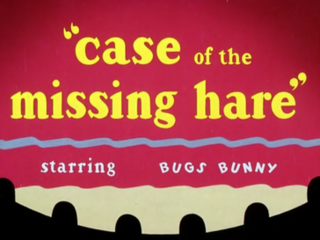
Case of the Missing Hare is a 1942 Warner Bros. cartoon in the Merrie Melodies series, directed by Chuck Jones and starring Bugs Bunny. The short was released on December 12, 1942.

Rumors is part of the Private Snafu series of animated shorts produced by Warner Bros. during World War II. Released in 1943, the cartoon was directed by Friz Freleng.

Going Home is part of the Private Snafu series of animated shorts produced by Warner Bros. during World War II. Made in 1944, the 4 minute cartoon features the vocal talents of Mel Blanc and was directed by Chuck Jones. The screenwriters for the Snafu cartoons were typically uncredited, though some animation historians believe that the writer of this short was Dr. Seuss.
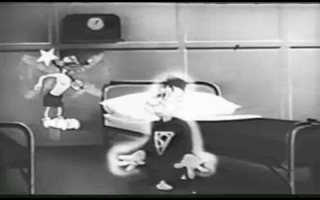
Snafuperman is a 1944 animated short comedy produced by Warner Bros. and directed by Friz Freleng. It is one of a series of black and white "Private Snafu" cartoons created for the Army-Navy Screen Magazine and shown only to American soldiers. The "Private Snafu" cartoons were not released commercially, until December 2010. The cartoon's title is a play on "Superman" and parodies the popular Superman cartoons of the 1940s.
Bacall to Arms is a 1946 Warner Bros. Merrie Melodies series short planned by Bob Clampett and finished by Arthur Davis, in his second-to-last cartoon at Warner Bros. The short was released on August 3, 1946.
Of Thee I Sting is a 1946 Warner Bros. cartoon directed by Friz Freleng, written by Michael Maltese and narrated by Robert C. Bruce that is a parody of World War II documentaries. Material was reused from the Target Snafu cartoon. The short was released on August 17, 1946.

A Lecture on Camouflage is a 1944 American animated film directed by Chuck Jones, a Private Snafu cartoon short made for the troops during World War II.

Commando Duck is a Walt Disney anti-Japanese propaganda cartoon starring Donald Duck. It was released on June 2, 1944.
Gas is an animated short, directed by Chuck Jones and first released in May 1944. It features Private Snafu learning the value of a gas mask in warfare. The cartoon was produced by Warner Bros. Cartoons. The script writers for the Snafu cartoons were typically uncredited, though animation historians consider that several of them were written or co-written by Dr. Seuss and Munro Leaf.
The Chow Hound is an animated short, directed by Frank Tashlin and first released in June 1944. It is part of the Private Snafu series.
Censored is an animated short, directed by Frank Tashlin, produced by Leon Schlesinger and first released in July 1944. It is part of the Private Snafu series.
Outpost is an animated short film, directed by Chuck Jones and first released in August 1944. It is part of the Private Snafu series. As in all the Snafu films, the voice of Private Snafu is performed by Mel Blanc.
Payday is an animated short film, directed by Friz Freleng and first released in September 1944. It is part of the Private Snafu series. As in all the Snafu films, the voice of Private Snafu is performed by Mel Blanc.
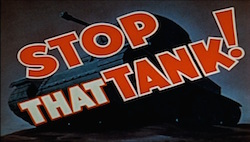
Stop That Tank! is a 22-minute 1942 instructional film created during World War II by Walt Disney Productions for the Directorate of Military Training, The Department of National Defence and the National Film Board of Canada (NFB). Its purpose, akin to "edutainment", was to instruct Canadian soldiers in the handling and care of the Boys Mk.1 Anti-tank rifle for use in combat against Nazi tanks. The film presented information in an entertaining manner as well as providing an anti-Nazi propaganda message.

Scrap the Japs is a 1942 American anti-Japanese cartoon with the popular character Popeye as protagonist. It follows his adventures after being sent for punishment on a ship and running into Japanese sailors.










